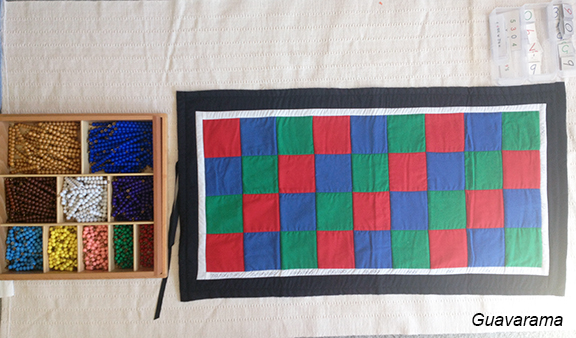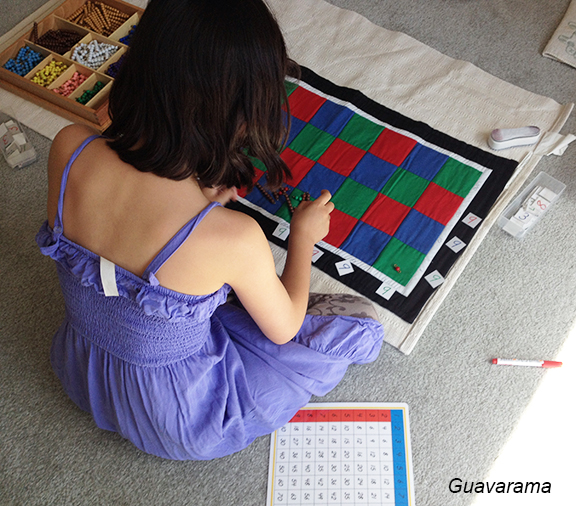 Age: 7.5
Age: 7.5
Presentation: Checkerboard multiplication, presentation #1, #2, #3.
I’ve been hitting Thumper with various presentations in my elementary math album. Any presentation that should be at least introduced in first grade. At my last training class, I finally asked my trainer about scope and sequence and she basically said that I can introduce a topic, study it a bit, drop this subject, and then come back again next year where I review and introduce a higher level of the same topic. It’s a spiral curriculum. This relieved me of feeling “How am I supposed to cover ALL this by the end of this year?!” And freed me to just present all age-appropriate presentations to her now.
This week we worked on check board multiplication. Checkerboard multiplication comes after the Large Bead Frame. The checkerboard kind of mimics the multiplication process, except it breaks down the steps for you. By multiplication process I mean, we take the unit of the multiplier and we multiply the multiplicand, then we take the tens and multiply the multiplicand, then we take the hundreds place of the multiplier and multiply the multiplicand, etc.
This entry may not make sense unless you’ve seen the presentation:
I introduced the checkerboard early in the week. I was surprised at how long it took me to introduce the concept that a unit bead changes its value depending on where you place it in the checkerboard. And we spent a LONG time with naming the numbers. Montessori math is not designed for the Chinese math system. She colored coded each place value green, blue, red. So green 1, blue 10, red 100, green 1,000, blue 10,000, red 100,000. Because these are the “families” (thousands family, millions family, billions family, etc). But Chinese really puts the comma after 4 zeros. Our counter really starts repeating after 10,000. So really we would say 1,0000,0000 for 100,000,000.
It’s all very complicated. We tried to make a cheat sheet noting the place value names into Chinese. That didn’t quite work since the checkerboard itself puts the commas in the “wrong” place for Chinese. So finally I just taught her how to say it properly in English. I’m going to have her “read” her answer when she writes by putting the comma in the right place first. Otherwise I think it’s a lost cause. I recite the place value names myself every time I’m looking at numbers and trying to say what it is in Mandarin.
Finally we worked on one 4 digit by 2 digit problem. It took awhile and was slow going. We started with just taking 5-bars 3 times. But she wanted to just multiply in her head and put the answer down. (Another clue she’s slowly passing out of the phase for using concrete materials.) We verified our answer on the Large Bead Frame and it all worked out. By then we were really brain tired so I stopped us. But I felt that Thumper didn’t really really get the process. And the whole point of these exercises is to really just get the process through manipulation of materials. I determined I needed to re-present rather then just ask her to work on a problem.

So today, we worked on it again. We started again with 4 digit x 2 digit. Much easier second time around. I gave her the multiplication memorization chart to look up her answers (and also sneakily practice multiplication memorization). Next she wanted to see how she could reach the right most square (thereby reaching 100,000,000). First she suggested 9999 x 999. That didn’t quite get us there. I suggested she try 9999 x 9999. It did, but not far enough apparently. She wanted ALL the squares to be filled.
Now, if you fill all the squares, you actually would be reaching 100,000,000,000+. But what numbers to multiply to reach that number? I suggested she fill each square with a 9 bead bar and work backwards. What multiply by what equals 9? Probably should have let her figure it out here. But it turns out that this problem showed me that she didn’t quite have the process down because we had to review how each checker square gets its value. We arrived at the fact that we needed to multiply 999,999,999 x 1,111.
Long story short, she filled each square, slid them across and down, added them up, and got a huge number.
She was very satisfied.
I was also very happy to see something that Montessori observed happening in my classroom. Namely she said that the elementary children (especially 6-9) love BIG things; big numbers, the enormity of the universe, etc. That’s why she started her curriculum with the presentation of the universe, unlike the typical school curriculum of starting with your community. It’s also why you don’t introduce written equations when you introduce a math concept for the first time. And why we’re told to just have the children make up numbers themselves. Because it gives kids the opportunity to really explore math concepts, rather than learn the mechanical steps of solving equations. (And really why you don’t do math worksheets, even though I’m not listening lalala) It gives children the choice, the freedom, to explore and play with these big numbers if they want to.
It used to freak me out that the math curriculum scope and sequence isn’t quite laid all out for me and and covers so many materials. But now that I’m doing the presentations I can see why. You kind of just present it to the child, and the child will let you know how concrete or how abstract you need to make the presentation so that it’s at their level.
Definitely a good math week this week.
